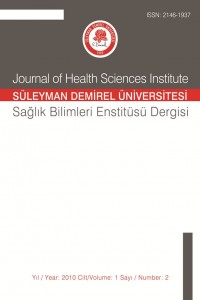Öz
ABSTRACT
Objective: In this study, it was proposed that to determination of effect of four different polishing applications on surface contact angle of composite samples after polimerizing with a halogen light unit.
Method: In the study, a hybrid composite resin (Filtek-Z250) was used. The composite resin samples (with “10mm diameter x 2mm highness” sizes) were prepared in cylindirical teflon molds and they were polymerized with a halogen light unit. Then they were ground with a carborundum paper with 600 grid. Four different polishing procedures were applied on surfaces of samples; 1-Kerr-Hawe polishing discs set, 2-BisCover-LV light-polimerized polishing burnish, 3- Enhance; Prisma Gloss polishing pat/finishing discs/rubber, 4- Enhance; Prisma Gloss Extra-Fine polishing pat/finishing discs/rubber (n=7). “Contact-Angle Measurement Device” (Easy Drop Gonyo-meter, Krüss, Hamburg, Germany) was used to measure the contact angles of samples. The right and left contact angles of each drop were measured with “droplet method” and mean ranges were calculated. Data was determined with Two-Way Variance-Analyse and Dunnet-T3 Multi-Comparison-Test statistically (p<0,05).
Results: There was statistical difference between polishing procedures (p<0,05). The lowest surface contact angle values were gained with Enhance; Prisma Gloss polishing pat/finishing discs/rubber set, and the highest surface contact angle values were obtained with BisCover-LV light-polimerized polishing burnish.
Discussion: In this study, generally, it was observed in composite samples polimerized with halogen light unit that, the lowest surface contact angle was found with a polishing pat/finishing discs/rubber set and the highest surface contact angle was got with a polishing burnish applied alone.
Key words: Adhesive Restorative Materials, Adhesion to teeth, Surface energetics in adhesion.
Anahtar Kelimeler
Öz
Özet
Amaç: Bu çalışmada, halojen ışık kaynağı ile polimerize edilen kompozit rezin örneklere dört farklı polisaj işlemi uygulanmasının, örneklerin yüzey kontakt (temas) açısı üzerine etkisinin belirlenmesi amaçlanmıştır.
Yöntem: Çalışmada, hibrit bir kompozit rezin olan Filtek-Z250 kullanıldı. “10mm x 2mm” ebatlarındaki silindirik şekilli teflon kalıplarda hazırlanan kompozit örnekler halojen ışık kaynağıyla polimerize edildi ve 600 gridlik zımpara kağıdı ile zımparalandı. Örnek yüzeylerine; “1-Kerr-Hawe polisaj diskleri seti, 2- BisCover-LV ışıkla-sertleşen rezin polisaj cilası, 3- Enhance; Prisma Gloss polisaj patı/bitirme diskleri/lastiği seti, 4- Enhance; Prisma Gloss Extra-Fine polisaj patı/bitirme diskleri/lastiği seti” olmak üzere dört farklı polisaj seti ile polisaj işlemi uygulandı (n=7). Örneklerin yüzey temas açılarının ölçülmesinde “Temas-Açısı Ölçüm Cihazı” (Easy Drop Gonyo-meter, Krüss, Hamburg, Germany) kullanıldı. “Damlacık yöntemi” ile ve her damlacığın sağ ve sol temas açıları ölçülerek ortalama değerler hesaplandı. Veriler, İki-Yönlü Varyans-Analizi ve Dunnet-T3 Çoklu-Karşılaştırma-Testi'yle istatistiksel olarak değerlendirildi (p<0,05).
Sonuçlar: Polisaj işlemleri arasında istatistiksel farklılıklar bulundu (p<0,05). En düşük yüzey temas açısı değerleri sağlayan polisaj işlemi, Enhance; Prisma Gloss polisaj patı/bitirme diskleri/lastiği seti ile, en yüksek yüzey temas açısı değerleri gösteren polisaj işlemi ise BisCover-LV polisaj cilasıyla elde edildi (p<0,05).
Tartışma: Bu çalışmada, halojen ışık kaynağıyla polimerize edilen kompozit örneklerde genel olarak, bir polisaj patı/bitirme diskleri/lastiği seti ile en düşük yüzey temas açısının elde edildiği, tek başına uygulanan bir polisaj cilası ile ise en yüksek yüzey temas açısının meydana geldiği belirlendi.
Anahtar Sözcükler: Adeziv Restoratif Materyaller, Dişlere Adezyon, Adezyonda yüzey enerjisi.
Abstract
Objective: In this study, it was proposed that to determination of effect of four different polishing applications on surface contact angle of composite samples after polimerizing with a halogen light unit.
Method: In the study, a hybrid composite resin (Filtek-Z250) was used. The composite resin samples (with “10mm diameter x 2mm highness” sizes) were prepared in cylindirical teflon molds and they were polymerized with a halogen light unit. Then they were ground with a carborundum paper with 600 grid. Four different polishing procedures were applied on surfaces of samples; 1-Kerr-Hawe polishing discs set, 2-BisCover-LV light-polimerized polishing burnish, 3- Enhance; Prisma Gloss polishing pat/finishing discs/rubber, 4- Enhance; Prisma Gloss Extra-Fine polishing pat/finishing discs/rubber (n=7). “Contact-Angle Measurement Device” (Easy Drop Gonyo-meter, Krüss, Hamburg, Germany) was used to measure the contact angles of samples. The right and left contact angles of each drop were measured with “droplet method” and mean ranges were calculated. Data was determined with Two-Way Variance-Analyse and Dunnet-T3 Multi-Comparison-Test statistically (p<0,05).
Results: There was statistical difference between polishing procedures (p<0,05). The lowest surface contact angle values were gained with Enhance; Prisma Gloss polishing pat/finishing discs/rubber set, and the highest surface contact angle values were obtained with BisCover-LV light-polimerized polishing burnish.
Discussion: In this study, generally, it was observed in composite samples polimerized with halogen light unit that, the lowest surface contact angle was found with a polishing pat/finishing discs/rubber set and the highest surface contact angle was got with a polishing burnish applied alone.
Key words: Adhesive Restorative Materials, Adhesion to teeth, Surface energetics in adhesion.
Anahtar Kelimeler
Ayrıntılar
| Birincil Dil | İngilizce |
|---|---|
| Bölüm | Araştırma Makaleleri |
| Yazarlar | |
| Yayımlanma Tarihi | 5 Ocak 2011 |
| Gönderilme Tarihi | 28 Kasım 2010 |
| Yayımlandığı Sayı | Yıl 2010 Cilt: 1 Sayı: 2 |


